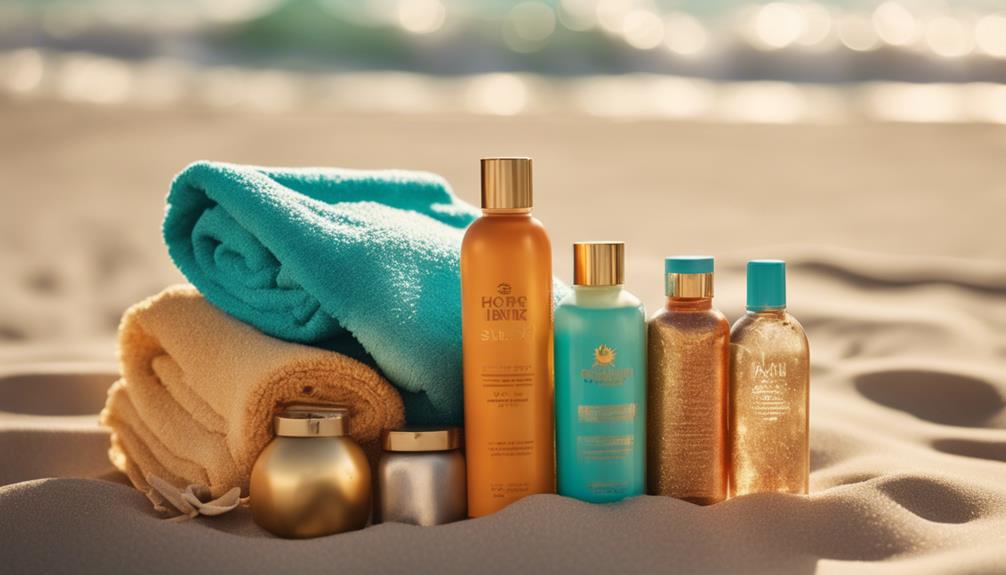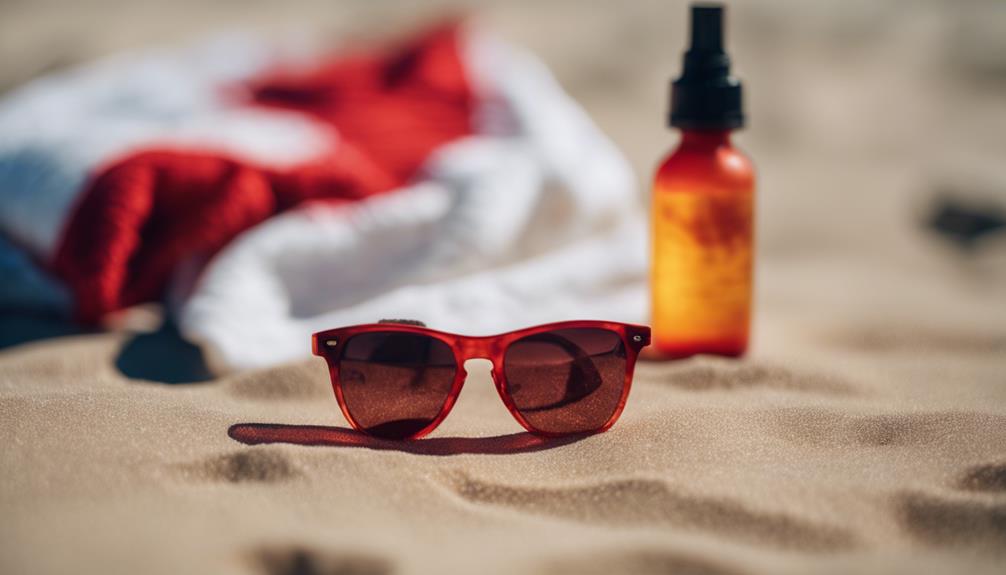To safely enjoy tanning, it is important to first determine your skin type, as this will impact how long you can tan without getting sunburned. It is recommended to set time limits based on your skin tone: individuals with fair skin should start with just 3-5 minutes, while those with darker skin can tan for a longer period of time. Choose a bronzer that matches your skin tone and consider using one with SPF for additional protection. Don’t forget to wear protective eyewear and apply lotion before tanning. Stay hydrated and regularly check your skin for any unusual changes. By following these important guidelines, you will ensure a safer tanning experience and may even discover more helpful advice.
Key Takeaways
- Determine your skin type to set appropriate tanning time limits and avoid burns.
- Always use a bronzer suitable for your skin tone and consider SPF for added protection.
- Practice safe tanning by wearing protective eyewear and applying moisturizer before and after sessions.
- Stay hydrated by drinking plenty of water and using quality moisturizers to prevent dryness.
Determine Your Skin Type
To achieve a safe and effective tan, you need to first determine your skin type and how it reacts to UV exposure. Your skin type plays an important role in how quickly you tan or burn.
If you have fair skin, you're likely more prone to burning, while those with darker skin can typically tolerate longer sun exposure. It's important to listen to your skin's signals; if it starts to feel uncomfortable or turns red, it's time to stop.
If you have a history of skin conditions or skin cancer, consulting a dermatologist for personalized advice is crucial.
Set Tanning Time Limits
Understanding your skin type helps you set appropriate tanning time limits to avoid overexposure and potential damage.
Start with short sessions based on your skin type: if you have fair skin, limit initial exposure to 3-5 minutes, gradually increasing to a maximum of 10 minutes.
For medium skin, begin with 5-7 minutes and aim for no more than 15 minutes.
If you have dark skin, kick off with 7-10 minutes and cap it at 20 minutes.
Always consult tanning professionals for personalized advice.
Avoid guessing; use a timer to track your sessions.
Only increase your tanning time if your skin tolerates it well, ensuring you prioritize safety and skin health throughout the process.
Choose the Right Bronzer

Choosing the right bronzer lotion is essential for achieving a natural-looking tan while keeping your skin healthy. Look for products that match your skin tone, hydrate your skin, and contain SPF for added protection. Here's a quick comparison to help you decide:
| Skin Tone | Bronzer Type | Key Benefits |
|---|---|---|
| Fair | Light lotion | Enhances glow, prevents streaking |
| Medium | Creamy bronzer | Provides hydration, even application |
| Dark | Gel bronzer | Deepens color, long-lasting effect |
Practice Safe Tanning Habits
Practicing safe tanning habits is vital for protecting your skin from harmful UV damage while achieving a beautiful glow.
First, know your skin type; fair skin burns easily, while darker skin can tolerate longer exposure. Start with short tanning sessions—3-5 minutes for fair skin—gradually increasing time only if your skin responds well.
Use protective eyewear to shield your eyes from harmful rays. Always apply a bronzer lotion that hydrates and provides SPF protection to your skin.
Set timers for your sessions to avoid overexposure, and don't forget to listen to your skin's signals. If you notice any discomfort or unusual changes, it's important to stop tanning immediately and consult a dermatologist for advice.
Stay Hydrated and Monitor Skin

How can you guarantee your skin stays healthy while tanning? Staying hydrated and monitoring your skin's condition are essential steps for a safe tanning experience.
Here's how you can do it:
- Drink Water: Aim for at least eight glasses of water a day to keep your skin hydrated.
- Use Moisturizers: Apply a good quality moisturizer before and after tanning to prevent dryness.
- Check for Changes: Regularly inspect your skin for any unusual spots or changes in color.
- Limit Exposure: Keep an eye on your tanning time to prevent overexposure and sunburn.
Frequently Asked Questions
Can I Tan Indoors and Outdoors Interchangeably?
Yes, you can tan indoors and outdoors interchangeably. Just remember to monitor your skin's response, adjust your tanning duration accordingly, and apply protective products to avoid overexposure and maintain your skin's health.
How Often Can I Tan Without Risking Skin Damage?
You can tan a few times a week, but listen to your skin. Monitor for irritation, and always start with shorter sessions. Gradually increase time, ensuring you're protecting your skin from potential damage.
What Are the Signs of Overexposure to UV Rays?
If you're turning into a lobster or feeling like you've been scorched by the sun, it's time to pay attention! Redness, blistering, or peeling skin are unmistakable signs you've overexposed yourself to UV rays.
Are There Natural Alternatives to Tanning Lotions?
Yes, there are natural alternatives to tanning lotions. You can use ingredients like cocoa powder, coffee grounds, or even carrot oil for a sun-kissed look. Just make certain you're still protecting your skin from UV damage!
How Can I Maintain My Tan Longer?
While you bask in the sun's glow, don't forget hydration's cool touch. Moisturize daily, exfoliate gently, and consider bronzer lotions for a lasting tan. Balance maintenance with care, ensuring your skin remains healthy and vibrant.
What are the Safety Tips for Tanning to Ensure a Perfect Tan?
When it comes to achieving a flawless tan, following essential tanning preparation tips is crucial. Always exfoliate your skin before tanning to remove dead skin cells and ensure an even tan. Use a high SPF sunscreen to protect your skin from harmful UV rays, and avoid prolonged sun exposure during peak hours.
How Do I Safely Enjoy Tanning with Perfect Preparation?
Before soaking up the sun, remember these essential tanning preparation tips. Exfoliate to remove dead skin, moisturize for hydration, and use sunscreen to protect your skin. Start with shorter sessions to avoid sunburn and gradually increase exposure. Stay hydrated and take breaks in the shade. Enjoy a safe and glowing tan.
What Are the Safety Precautions for Tanning to Ensure a Perfect Tan?
Before tanning, follow these perfect tanning preparation tips for a safe and effective tan. Always use sunscreen with a high SPF to protect your skin from harmful UV rays. Limit your time in the sun and consider using self-tanning products for a healthy glow without sun damage.
Conclusion
As you set off on your tanning adventure, remember to channel your inner sun goddess, basking in the warmth while keeping safety in focus.
Just like Odysseus steering the seas, you can enjoy your journey without running into treacherous waters.
By knowing your skin type, respecting time limits, and choosing the right products, you'll achieve that radiant glow without the sunburn.
So, embrace the sunshine, but be wise—your skin will thank you!










